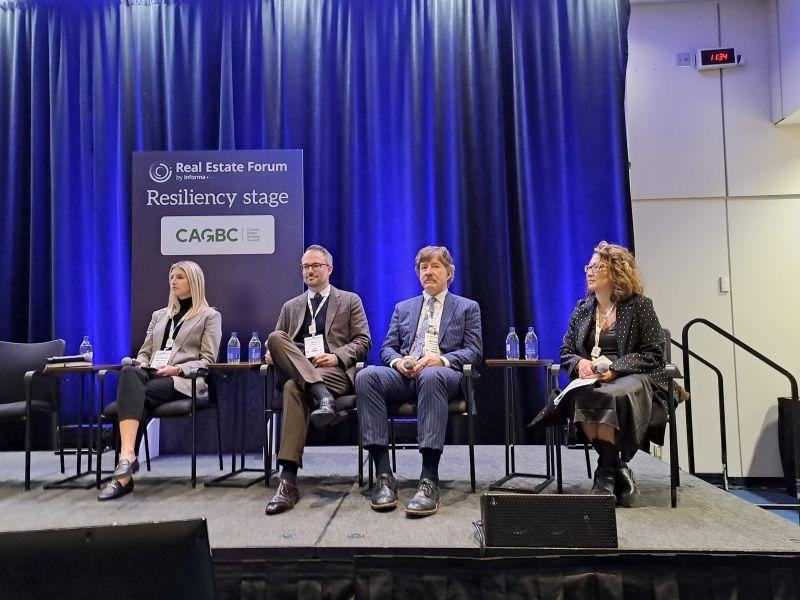
Sustainable Buildings Canada (SBC) appointed Brynn Nheiley its new executive director earlier this month, and her mandate to strengthen collaboration between the private and public sectors could prove a boon for the country’s smaller green builders.
“Municipal governments have noble aspirations of bringing sustainable housing to their communities, but they’re having a hard time connecting with smaller-scale developers for whom efficient processes — and knowing what their targets are up front — is fundamental to their bottom lines,” Nheiley, whose role began Nov. 12, told Sustainable Biz Canada.
It largely comes down to a “language barrier” between regulators and developers, she added.
“There’s a lot of concern out there right now from smaller-scale developers that entering into a higher-tier construction standard is just not affordable once they factor in the time they think it’s going to take them to go through the process.”
SBC hired Nheiley in large part because she’s a veteran of both the private and public sectors. In succeeding Mike Singleton, SBC’s co-founder who just retired, she’ll leverage her vast network to broker partnerships while expanding the not-for-profit’s reach and enhancing awareness about the merits of sustainability.
Because Adam Jones was also promoted to director of operations — among his new functions are running SBC’s workshops, seminars and webinars — and will take over some of Singleton’s former duties, Nheiley likened the execution of her mandate to having a clear flight path.
“Being able to do what I’ll call ‘translation’ between municipalities and the building industry will help both of them achieve those really valuable objectives, and those smaller developers and designers will see an effective and profitable business path,” Nheiley continued.
Nheiley a seamless fit for Sustainable Buildings Canada
Nheiley's studies in architecture in the mid-2000s ended up spurring an ancillary interest in environmentalism. That ultimately redirected her curiosity toward carbon footprints — both their potentially deleterious nature and the uniquely countervailing solutions championed by the then-burgeoning sustainable building field.
She began her career in architecture as a sustainable building, design and construction consultant, which included leading Greater Toronto Area-based projects like revamping Union Station’s subway platforms and intermodal connectivity, as well as designing Kennedy Station’s terminal and Mississauga’s bus rapid transit station.
She was also a sustainability coordinator at WHW Architects, managing various LEED-certified projects; a land-use planner at Ekistics Planning & Design in Atlantic Canada, where she remained to subsequently work as Halifax-based UPLAND’s planner; then as the Town of Antigonish, N.S.’s acting planning director and development officer.
Upon returning to Southwestern Ontario, the City of Hamilton hired Nheiley as its senior planner before neighbouring Burlington tapped her to join its senior leadership team, where she oversaw community planning, building, transportation, transit and by-law compliance.
Her experience in the public and private sectors is tantamount to bridge building, she said.
“It’s making sure developers frame their proposals in a way that can be received by municipalities,” she explained. “And having conversations with municipalities to make sure they’re being crystal clear about their objectives and metrics so they’re setting applicants up for successful outcomes.”
The sustainable case for asset retention
SBC has always been active within the commercial building space’s various sub-sectors, and will remain so under Nheiley’s stewardship.
She’s particularly bullish about those assets because, if built sustainably, their owners would benefit from lower overhead and robust tenancy demand, thereby reaping greater returns on their investments.
And that, Nheiley believes, will catapult Canada’s sustainable building industry forward.
“The builders I see making some of the deepest investments in green upgrades are the ones who intend to hang on to their building stock and who see the long-term payoff, because they’ll be able to offer spaces within their buildings that have competitive advantages,” Nheiley said.
“Tenants, whether they’re looking for residential or commercial space, see that as a great asset themselves and where they should locate.”
SBC, she added, can play a critical role in helping builders achieve their objectives, including eligibility for superior financing programs and incentives.
Financing critical to sustainable goals
Canada is replete with successful examples of sustainable developments, like Blatchford in Edmonton, which Nheiley touted as a case study for municipalities in bigger cities. Roughly as large as the city’s downtown, Blatchford — which will have two LRTs and rely on both renewable energy and a district energy-sharing system — is on its way to becoming Canada’s largest sustainable community.
This is where Nheiley’s experience could prove pivotal. Noting financial programs like the Canada Mortgage and Housing Corporation’s MLI Select exist to incentivize sustainable building, she believes success stories like Blatchford can persuade lenders to unlock even better financing programs.
Lenders may indeed become increasingly familiar with SBC because, according to Nheiley, enhanced collaboration will make winners out of all the building industry’s various stakeholders.
“We definitely need to make sure that programs aren’t set up to only help those who can afford upfront costs and get a grant out of it,” she said. “If someone can’t afford the upfront costs, it’s a barrier to achieving those efficiency objectives, so similar financing programs are absolutely critical.
“In order to give owners of those buildings, whether they’re building new or trying to upgrade their existing building stock, we need to make sure that financial mechanisms are in place to get people started.”










